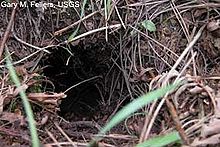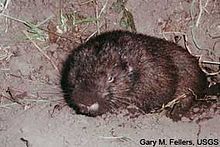- Mountain Beaver
-
Mountain Beaver
Temporal range: Late Pleistocene–Recent
Conservation status Scientific classification 
Kingdom: Animalia Phylum: Chordata Class: Mammalia Order: Rodentia Suborder: Sciuromorpha Family: Aplodontiidae Subfamily: Aplodontiinae Genus: Aplodontia Species: A. rufa Binomial name Aplodontia rufa
(Rafinesque, 1817)The Mountain Beaver (Aplodontia rufa) is the most primitive extant rodent. Not to be confused with the North American beaver[2] Castor canadensis, or its relative the Eurasian beaver, Castor fiber,[3] it has several common names including Aplodontia, Boomer, Ground Bear, and Giant Mole. The name Sewellel Beaver comes from sewellel or suwellel, the Chinookan term for a cloak made from its pelts. This species is the only living member of its genus, Aplodontia, and family, Aplodontiidae.[4]
Contents
Characteristics
Mountain Beavers are brown in color, but fur can range from slightly more reddish to more blackish depending on subspecies. There is a light patch under each ear. The animals have distinctively short tails. Adults weigh about 500–900 g (18–32 oz) with a few specimens topping 1,000 g (35 oz). Total length is about 30–50 cm (12–20 in) with a tail length of 1–4 cm (0.39–1.6 in).
The skull is protrogomorphous. This means that it has no specialized attachments for the masseter muscles as seen in other rodents. It is flattened and lacks a postorbital process. The baculum is thin and distinctly forked. The penis is about 4.5 cm (1.8 in) in length. They do not have a true scrotum, but testes move into a position called semiscrotal during the breeding season[citation needed].
Mountain Beavers have an unusual projection on each molar and premolar which is unique among mammals and allows for easy identification of teeth. This projection points toward the cheek on the upper toothrow, but points toward the tongue on the lower. The cheek teeth lack the complex folds of other rodents and instead consist of a single basin. They are hypsodont and ever-growing. Two upper and one lower premolars are present, along with all the molars, giving a dental formula of

Mountain Beavers cannot produce concentrated urine. They are thought to be physiologically restricted to the temperate rain forest regions of the North American Pacific coast and moist microenvironments inland due to their inability to obtain sufficient water in more arid environments[citation needed]. Their karyotype is 2n=46.
Habits and distribution
Mountain Beavers are found in the coastal mountains of British Columbia and southward to include the Cascades Mountain ranges, the Siskiyous, Sierra Nevada mountain range of California within North America.[5] They range from sea level to the tree line.[5] They can be found in both deciduous and coniferous forests, but throughout most of the range appear to prefer the former. These animals appear to be physiologically limited to moist microenvironments, with most subspecies occurring only in regions with minimal snowfall and cool winters. They do not appear to be able to conserve body heat or warmth as efficiently as other rodents.[6] They do not hibernate.
Mountain Beavers build elaborate burrow systems with chambers devoted to fecal and food caches. They exhibit coprophagy and eat soft fecal pellets to obtain maximum nutrients. Hard fecal pellets are transferred to fecal chambers using their incisors. Food includes fleshy herbs and young shoots of more woody plants. Ferns probably make up the bulk of the diet. They appear to be strictly vegetarian.[6] Their consumption of seedling trees has led some to consider them a pest. They appear to build hay mounds at some burrow entrances, but whether this behavior is related to water regulation, curing food, or gathering nest materials is debated.
A host of other animals have been documented[citation needed] within the burrow system of Mountain Beavers. These include: Long-tailed Weasels, Ermines, Minks, Fishers, American Badgers, raccoons, Western Spotted Skunks, Striped Skunks, Brush Rabbits, Snowshoe Hares, Douglas Squirrels, Western Jumping Mice, Water Voles, California Voles, White-footed Voles, Western Red-backed Voles, Deer Mice, Bushy-tailed Woodrats, Dusky-footed Woodrats, Botta's Pocket Gopher, American Shrew Moles, Coast Moles, and Pacific Giant Salamanders (Carraway and Verts, 1993). Because of their effect on such a wide variety of plants and animals, some ecologists[who?] consider Mountain Beavers to be a keystone species.
Known predators include Bobcats, Coyotes, Cougars, Golden Eagles, and Owls. Among the parasites of the Mountain Beaver is the largest flea known to modern science, Hystrichopsylla schefferi. Females of this flea can be 8 mm (0.31 in) long. [1]
The breeding season is between January–March with 2-3 young born February–April. The young are born hairless, pink, and blind. Longevity is 5–10 years, fairly long as rodents go. They are not social, though home ranges can overlap.[6]
Mountain Beavers are capable of climbing trees,[7] but rarely travel far from burrows. The thumb is slightly opposable and the animals will sit on their hindquarters and manipulate food with their forelimbs and incisors.
Spelling and etymology
Most references use the spelling Aplodontidae for the family name. This has been deemed incorrect due to the technical rules of converting a genus name into a family name. The proper conversion of Aplodontia to a family name is to drop the -a only and add -idae. Thus, Aplodontiidae is technically correct. This spelling is gaining acceptance in modern texts.
Alternate spellings of the genus name have also been reported, with as many as 30 variants historically. These include Haplodontia, Haplodon, Aploodontia, Apluodontia, and Aplodontie among others. The name Aplodontia means "simple tooth" and is in reference to the single large basin comprising the bulk of each cheek tooth. The specific epithet, rufa means red or reddish.
Subspecies
At present seven subspecies of Aplodontia rufa are recognized.
Aplodontia rufa californica (Peters, 1864)
- Distributed throughout the Sierra Nevada range in Northern California and extreme western Nevada.
Aplodontia rufa humboldtiana Taylor, 1916
- Restricted to the far Northwestern coast of California.
Aplodontia rufa nigra Taylor, 1914
- Restricted to a small region in southern Mendocino County, California.
Aplodontia rufa pacifica Merriam, 1899
- Distributed across coastal Oregon.
Aplodontia rufa phaea Merriam, 1899
- Found in a small pocket just Northwest of San Francisco, California.
Aplodontia rufa rainieri Merriam, 1899
- Found across the Cascade Range from southern British Columbia to northern California.
Aplodontia rufa rufa (Rafinesque, 1817)
- Found along coastal Washington, particularly on the Olympic Peninsula.
Closest relatives
The Mountain Beaver is considered a living fossil by many researchers[who?] due to the presence of a host of primitive characteristics, particularly the protrogomorphous zygomasseteric system. This condition is similar to what is found in most mammal groups, such as rabbits, where no extreme specialization of the masseter muscle has evolved. In the protrogomorphous condition, the masseter muscle does not pass through the infraorbital foramen as it does in guinea pigs and mice. Likewise, the medial masseter muscle attaches to the base of the zygomatic arch and does not extend to the region in front of the eye as is seen in squirrels and mice. The Mountain Beaver is the only living rodent with this primitive cranial and muscular feature (except perhaps the blesmols who clearly evolved protrogomorphy from a hystricomorphous ancestor). The Mountain Beaver was once thought to be related to the earliest protrogomorphous rodents such as the ischyromyids like Paramys. Both molecular and morphological phylogeneticists have recently suggested a more distant relationship to these animals.
Molecular results have consistently produced a sister relationship between the Mountain Beaver and the squirrels (family Sciuridae). This clade is referred to as Sciuroidea, Sciuromorpha (not to be confused with the sciuromorphous zygomasseteric system), or Sciurida depending on the author.
According to the fossil record, the Aplodontioidea split from the squirrels in the Middle or Late Eocene as indicated by the extinct genera †Spurimus and †Prosciurus. The fossil record for the genus Aplodontia itself extends to the Late Pleistocene of North America.
References
- ^ Fellers, G. M., Lidicker Jr., W. Z., Linzey, A. V. & Nature Serve (Williams, D. F. & Hammerson, G.) (2008). Aplodontia rufa. In: IUCN 2008. IUCN Red List of Threatened Species. Downloaded on 6 January 2009.
- ^ Wood Beaver in The New Encyclopedia of Mammals. David Macdonald (ed). Oxford university Press, 2001. Page 596-597.
- ^ Beavers in The New Encyclopedia of Mammals. David Macdonald (ed). Oxford university Press, 2001. Page 590-591.
- ^ Helgen, Kristofer M. (16 November 2005). "Family Aplodontiidae (p. 753)". In Wilson, Don E., and Reeder, DeeAnn M., eds. Mammal Species of the World: A Taxonomic and Geographic Reference (3rd ed.). Baltimore: Johns Hopkins University Press, 2 vols. (2142 pp.). ISBN 978-0-8018-8221-0. OCLC 62265494. http://www.bucknell.edu/msw3/browse.asp?id=12300004.
- ^ a b Mountain Beaver in The New Encyclopedia of Mammals. David Macdonald (ed). Oxford University Press, 2001. Pages 596-597.
- ^ a b c Evans, James (1984). Macdonald, D.. ed. The Encyclopedia of Mammals. New York: Facts on File. pp. 610–611. ISBN 0-87196-871-1.
- ^ Tree Climbing by Mountain Beavers. Lloyd Ingles. Journal of Mammalogy, Vol. 41, No. 1 (Feb., 1960), pages 120-121.
- Adkins, R. M. E. L. Gelke, D. Rowe, and R. L. Honeycutt. 2001. Molecular phylogeny and divergence time estimates for major rodent groups: Evidence from multiple genes. Molecular Biology and Evolution, 18:777-791.
- Carraway, L. N. and B. J. Verts. 1993. Aplodontia rufa. Mammalian Species, 431:1-10.
- McKenna, Malcolm C., and Bell, Susan K. 1997. Classification of Mammals Above the Species Level. Columbia University Press, New York, 631 pp. ISBN 0-231-11013-8
- Nowak, R. M. 1999. Walker's Mammals of the World, Vol. 2. Johns Hopkins University Press, London.
- Feldhammer, George A.; Lee Drickamer, Stephen Vessey, Joseph Merritt, Carey Krajewski (2007). Mammology: Adaptation, Diversity, Ecology. Johns Hopkins University Press. ISBN 0-8018-8695-3.
Categories:- IUCN Red List least concern species
- Rodents
- Living fossils
- Mammals of Canada
- Mammals of the United States
- Fauna of the Sierra Nevada (U.S.)
Wikimedia Foundation. 2010.




